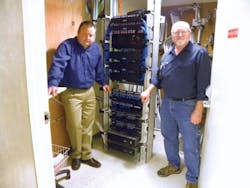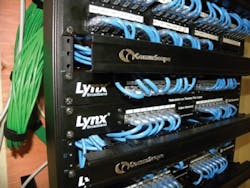Rather than installing new coax, Blessing Hospital used twisted-pair cabling and conversion technology.
BY GREGG KELLEY, LYNX BROADBAND
After years of deteriorating television quality, Blessing Hospital (www.blessinghealthsystem.org) in Quincy, IL had to make a change. Patients were complaining verbally and in patient-satisfaction surveys, listing poor picture quality, missing channels or no reception at all, as major sources of aggravation.
The problem's root cause was the 40-year-old coaxial cable TV network with hundreds of connectors, many of which had oxidation and leakage issues, according to Ron Rose, systems control specialist at the 403-bed hospital. The reoccurring results were weak signal strength, grainy or snowy pictures and some televisions that would not receive all 14 available channels.
Rose was constantly getting service calls. But faulty connectors were difficult to find, sometimes even more difficult to get to, and still more difficult to fix. He was reluctant to keep "patching up" the system and he resisted recommending the expenditure of up to $150,000 to replace old coaxial cable with new coaxial cable. Ultimately, the hospital decided to upgrade the television infrastructure to a Category 5e cabling network, using Lynx Broadband (www.lynxbroadband.com) products to convert coaxial signals into signals that travel on twisted-pair cable.
"What I hear from patients and the public is that it's such a great signal and it's a really good, sharp, clear picture," Rose said. "and patient surveys don't list picture-quality problems anymore."
Rose also likes the new layout of the television-network cabling system. "When I go to the IDF [intermediate distribution frame] closets where the Lynx hubs are installed, there is a direct home-run cable from a port on a hub to a TV in a patient room."
The new system was designed and installed by DM Mattson (www.dmmattson.com), a full-line electronic systems integrator. The system delivers 36 channels, which is more than double the number previously available, to 336 televisions in patient rooms as well as public areas on Blessing's five-floor patient tower.
adamsNet, a provider of cable TV, telephone and Internet service, delivers 29 channels via fiber-optic cable to the headend on the patient tower's top floor. The hospital also receives two satellite channels, one in English and the other in Spanish, with programming for parents of newborns. The other five channels provide in-house programming on heart health, rehabilitation, chaplain services, patient information and employee information.
RG-11 coaxial cable carries the signal from the headend to 10 IDFs, where the signal is then amplified and distributed to several Lynx hubs. The system includes six, eight-port hubs and eighteen, six-port hubs. Each hub splits the coaxial signal and uses RF baluns to convert it to balanced signals that travel on twisted-pair cables. Lynx wallplates in patient rooms and in public areas change the signals back to unbalanced coaxial form before they go into the televisions.
Lights out
"The best way I can describe our old coaxial system is to compare it to an old-style string of Christmas lights," Rose explains. "When one bulb goes bad, all the remaining bulbs on that string go bad too. You can waste a lot of man hours chasing down the cable to find out where you lost the signal before you even think about fixing it."
although medical systems, room décor and other patient conveniences had been updated over the years, the original television system was plagued by unbalanced signals, corrosion and bad connectors. "It was long overdue to be replaced," Rose says.
Blessing Hospital learned about the Lynx/Category 5e option from Mattson, which has provided security- and television-infrastructure work for the hospital for years. "We heard them talking about patient-satisfaction surveys reporting poor TV quality," says Dave Mattson, president of DM Mattson. "So we started talking to them about products that would solve the problem and futureproof their infrastructure for new technologies that use twisted-pair cable."
Making the leap
as Rose remembers it, "Mattson assured us that the Lynx Cat 5e network would dramatically improve picture quality and provide attractive options for the future, like IPTV and pay-per-view. That sold me. My supervisors agreed and we decided to go with it.
The new system was completed in February 2010 and cost approximately $150,000, including new Category 5e cabling, the Lynx equipment and the labor required to install the cabling in an existing building.
"Our techs were working in an 18-inch crawlspace above the ceilings, where they squirmed along on their elbows to install the cable," Mattson says. "That was a real challenge."
The installer also discovered that some cable runs would be longer than the 90-meter, in-wall standard. "as a result, we added more IDF closets," Mattson explains.
Patience for patients
Mattson continues, "another major challenge was the tremendous amount of daily communication needed to coordinate installation with the nursing staff. Patients had to be moved to different areas so our techs could work in the rooms. Sometimes we simply had to wait for the patients to be discharged before we could get into a room."
Rose compliments the technicians' performance: "Mattson did a real good job. They came in early and often left late. They worked very well with the nursing staff and minimized any inconvenience to the patients."
Perhaps most of all, Rose is pleased with the clear signal the new system delivers. "Our goal was to deliver a good picture to our patients, and that's what we did," he says.
In addition to delivering a clear television signal, the Category 5e cabling equips the hospital for later upgrades, such as HDTV, Internet Protocol television, digital signage, pay-per-view programming, Internet and email access, and electronic selection of menu items.
GREGG KELLEY is national sales and marketing manager for Lynx Broadband (www.lynxbroadband.com).


